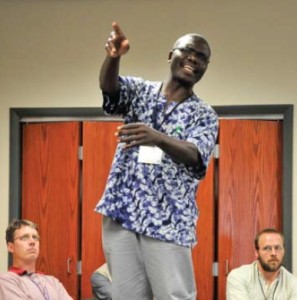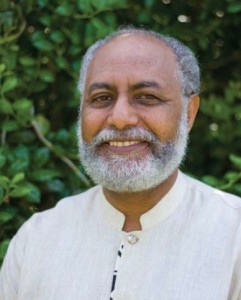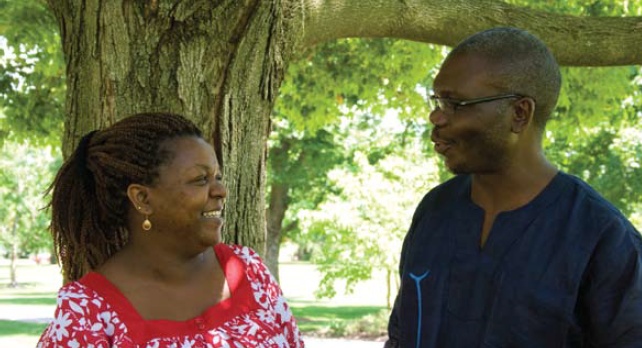
EMU’s Center for Justice and Peacebuilding (CJP) has more MA graduates in conflict transformation in Kenya than in any other country of the world, except the United States.
Thirteen graduate-level alumni or professors are based in Kenya. Our Summer Peacebuilding Institute has hosted 50 people from Kenya, including Dekha Ibrahim Abdi, one of six named from around the world as recipients of the 2007 Right Livelihood Award. Seven U.S.-based CJP faculty and staff members have done peace-themed work in Kenya.
So, where were “our” people when the killing started? Ironically, most were taking a brief break from their usual jam-packed work lives, like folks everywhere tend to do over the Christmas holiday period. Let’s look at these three people – Doreen Ruto, Babu Ayindo and Hizkias Assefa – as examples of the range of responses from the CJP group to the violence.
Doreen Ruto
Much of last year, Doreen Ruto, MA ’06, collaborated with Babu Ayindo, MA ’98, on developing a curriculum designed to teach conflict-transformation and peace education skills in Kenyan classrooms. By Christmas 2007, the UNICEF-funded project was nearing the pilot-stage of testing the curriculum in some schools and refining it. Ruto’s 11-year-old son Ronnie was out of school for the holiday period. (Her older son, Richard Bikko, was and is an undergrad at EMU.) She left Ronnie with cousins and went to vote on December 27.
“It was the first time in my life that I voted. I just was not interested before,” she says. “But after going through CJP, I went back and said, ‘We need to be part of the change.’”
(Ruto came to CJP as part of her healing process – and desire to explore the path of nonviolent change – after losing her husband, the father of her two sons, in a terrorist attack on the U.S. Embassy in Nairobi in 1998. Her husband was not the target of the attack; he was in a neighboring building that collapsed.)
“I stood six or seven hours on the queue to vote. I was so determined. I wanted to see a difference. I wanted Kenya to have a more inclusive government and not confine its leadership to one part of the country.”
Ruto comes from an ethnic group that is different from the one of the current president. To understand why this is highly significant in her country, read “Towards Understanding the Violence in Kenya” on page 17.
When the violence began, Ruto was at home in Nairobi with Ronnie. They were imprisoned by the violence. Outside their doors, in the streets, supporters of her ethnic group were attacking and killing others and vice versa. After three days, she decided “enough.” She phoned George Wachira, senior research and policy advisor of the Nairobi Peace Initiative, to discuss what steps to take.
By January 2, Ruto, Wachira, Abdi and about 60 others – including Jebiwot Sumbeiywo’s uncle, Lt. Gen. Lazarus Sumbeiywo – convened at the Serena Hotel in downtown Nairobi. They called themselves Concerned Citizens for Peace.
For Ruto, traveling via taxi to the meeting took faith and courage. Soldiers and tear gas filled the streets. Roaming bands of young men could easily stop a taxi and pull out a single female occupant whose ethnicity did not suit them. Ruto had left Ronnie in the care of relatives, hoping that she would be returning to her son at the end of the day.
About 10 of the 60 in Concerned Citizens for Peace had a history linking them to CJP and thus to each other. Perhaps most remarkable – and fortuitous in this situation – the Kenyans trained at CJP have come from seven different ethnic groups. Ruto sat across the table from Anne Nyambura, MA ’06, who comes from the ethnic group viewed to be “in power” in Kenya.
“As graduates of CJP, we speak the same language,” says Ruto. “We see what is going on through the same lenses. We condemn the same injustices, even if we may have voted differently.”
More on Ruto follows in Babu Ayindo’s story.

Babu Ayindo
Doreen Ruto’s collaborator on the UNICEF-funded peace curriculum for schools, Babu Ayindo, MA ’98, was among the first Africans to earn a master’s degree in conflict transformation at EMU.
If you Google his name, you will find that he has led trainings in places as diverse as South Korea, Fiji, Australia, the Philippines, and most countries in sub-Saharan Africa. He is renowned for using improvisational theater techniques in conflict transformation.
Yet at the end of December 2007, Ayindo was doing none of the above. He was in his backyard – literally. He was in a city on the edge of the Rift Valley. He was eight hours by bus from Nairobi, but only 100 meters from the area where violence would be the worst over the next several weeks.
“My wife and I have a quarter-acre farm where we raise cattle, goats, chickens. We grow passion fruit, mango, cabbage, kale, tomatoes, onions,” says Ayindo. “My wife grew up on a farm. We are resurrecting a tradition of sustaining oneself. Having constant contact with the land is important. I want my children to experience all this.”
Ayindo took a break from his gardening to cast his vote for the opposition on December 27. Not that he thought a new president might bring great change to Kenya – more equity, less corruption – but he thought it might be an improvement.
Then the attacks began on non-Luos in the streets outside his compound. Ayindo is Luo (though “I don’t look like the typical Luo”); his mother and wife are Luhya. “The crowds were out with stones and other crude weapons, looting and driving away people perceived to be sympathetic or to have voted for other parties (other than the Orange Democratic Movement). The police and the para-military were engaging the crowds with tear gas and live bullets.
“We kept down and away from the windows. Our three kids (ages 14, 10 and 4) came to recognize the sound of every type of gun. They saw their first dead people…I wish they hadn’t.”
By the end of the first week – a week with no water and electricity in his home – Ayindo was in cell-phone contact with George Kut of the Nairobi Peace Initiative. Kut flew to join Ayindo and by January 9 they were traveling through parts of the Rift Valley and Nyanza regions together, listening to people, particularly the youth, to learn more about what was going on. On January 12, they reported their findings back to the Nairobi Peace Initiative.
Their main recommendation was to urge peace workers to “listen deeply in order to understand the root causes of the unprecedented violence,” says Ayindo. The Nairobi Peace Initiative later expanded this “listening project” to other parts of Kenya.
Meanwhile, the Concerned Citizens for Peace had started circulating peace messages – “choose peace and not violence” and “let’s give dialogue a chance” – via cooperating cell phone companies and mass media. They put up a website, www.peaceinkenya.net, which presented constructive ways out of the conflict and offered the personal cell numbers of CCP’s leaders, including Abdi’s. Celebrities weighed in with a song of peace played widely on the radio. It began to be hummed throughout the country.
Out in the land of the center of the opposition, Ayindo felt that the youthful voices of despair that he had listened to over several days were not being addressed by the peace messages coming from Nairobi. “If the grievances of the people in the streets get ignored, another cycle of violence will occur. And I didn’t hear enough about addressing those grievances.”
Ayindo’s colleague Doreen Ruto – who had also voted for the opposition – was saddened by a text message she received after speaking on TV about the need for dialogue. A good friend texted: “We want justice and not peace.”
“I understood my friend’s anger,” says Ruto. “But my immediate priority was ending the loss of lives and the displacement of people from their homes. My greatest fear and concern was that if we went on like this, the violence would soon take the country to a point of no return. I tried to convince my friend of how the violence on the streets would soon catch up with us, even in the safety of our homes, but both of us seemed to be from two different worlds at that time. She wouldn’t hear of it.”
This exemplifies the truism that those working for peace also must deal with divergent views among themselves. In this case, Ayindo, Ruto, and Ruto’s friend saw the violence somewhat differently from their differing vantage points.

Hizkias Assefa
Hizkias Assefa, born in Ethiopia but based in Kenya, was among the founding group that launched CJP in 1994. Holding a PhD and JD, Dr. Assefa has taught at EMU’s annual Summer Peacebuilding Institute ever since.
Known globally as a skilled and trusted mediator, Dr. Assefa is often one of the unnamed faces in photos taken at negotiating tables, when the big-names finally come face-to-face despite their mutual hostility. It suits Dr. Assefa not to be in the news – it makes it easier for him to quietly offer guidance on how to talk and what to talk about.
When the elections took place in Kenya in late December, Dr. Assefa was on holiday with his family in neighboring Zanzibar. He returned a week after the elections to a country that felt profoundly different. “Everyone seemed to be polarized,” he says. “At the early stages of the violence, it was difficult to find citizens who could stand above this polarization and see the big picture.”
After the Concerned Citizens for Peace began to assert itself, Dr. Assefa says it took time for the public to recognize that the ad-hoc group crossed ethnic lines and that it was not aligned with one or the other side in the conflict.
Many leaders from other African countries poured into Kenya to try to stop the violence from escalating and to bring the parties to the negotiating table. After a few weeks a mediation process sponsored by the African Union got underway in the same Serena Hotel where the Concerned Citizens for Peace had been meeting.
The mediation was led by Kofi Annan, former secretary general of the United Nations. Also on the team were the former president of Tanzania, Benjamin Mkapa, and the former first lady of Mozambique and of South Africa, Graca Machel. Dr. Assefa was invited by Annan to join the mediation team.
“I was brought in as a mediation expert to help provide guidance on how to handle the negotiation process,” says Dr. Assefa. He dealt with such issues as how to structure the process, how to think through the root causes of the conflict, and how to help the parties move towards agreement. He also advised on overcoming obstacles, avoiding pitfalls, and involving civil society.
The Annan-led mediation process, held from late January to early May, is widely regarded as the turning point in easing the violence. From it came an agreement that moved the parties to a political solution to the crisis. The mediation process brought in national and international experts to help develop a powersharing government, as well as to design roadmaps for electoral, constitutional, land, public service and economic reforms to address the issues of the crisis.
“As a long-time resident of Kenya, I was directly affected by the conflict and could also see how it affected the lives of those around me,” says Dr. Assefa. “I therefore had an opportunity to bring the perspective of everyday Kenyans into the process.”
Dr. Assefa frequently argued for addressing the root causes of the conflict, such as the unequal distribution of resources, and not just papering them over. He said he sought consideration of the steps necessary for long-term stability and harmony, rather than being satisfied with temporary peace.
“Regrettably, addressing root causes is very complicated,” he says. “It is a long-term process. Once there is no immediate pressure of turmoil, it seems that the pressure is off of everyone – the politicians, the negotiators, the population, even the mediators and sponsors of the process. So people lose focus on the long-term underlying issues, and things slowly begin to return to business as usual.”
In Dr. Assefa’s eyes, one of the challenges of peacebuilding is getting people to recognize the factors likely to lead to destruction for a society and to take preventive steps before a crisis looms.
